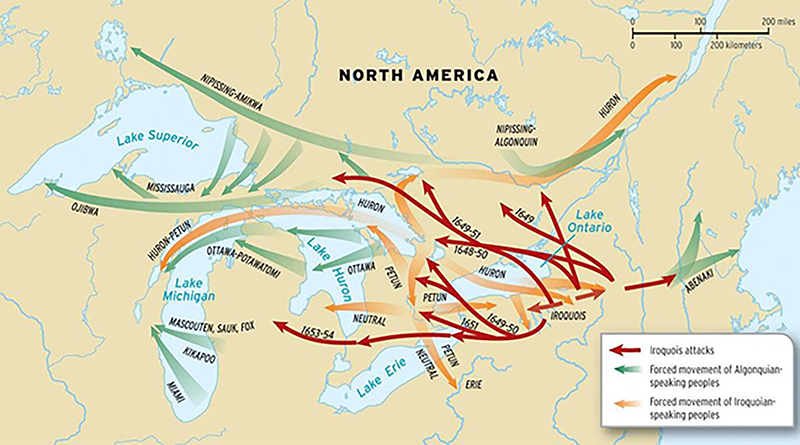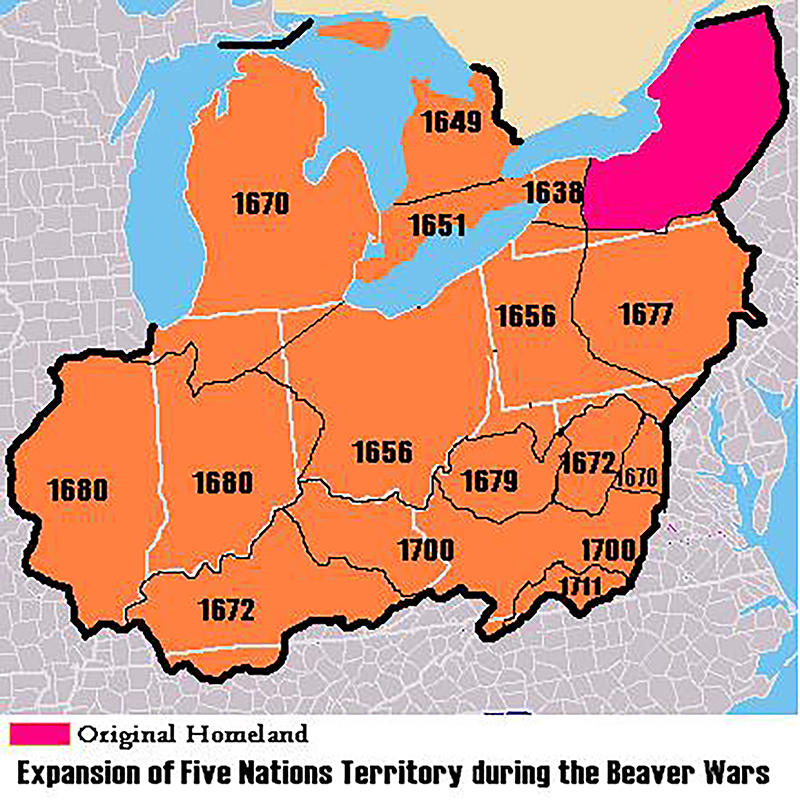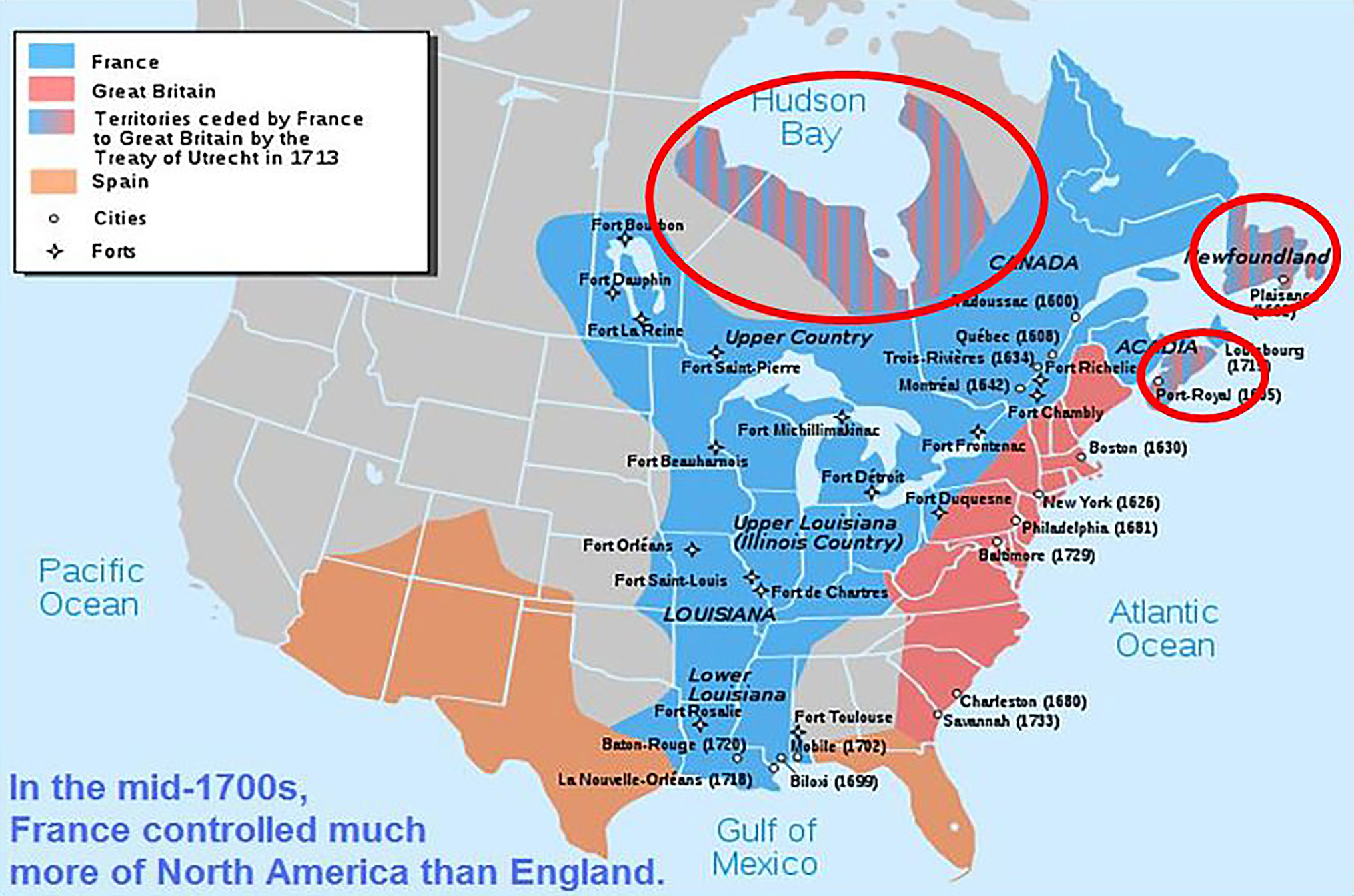This is just a brief overview of issues that affected the Potawatomi and the area that would eventually become Pulaski County, Indiana.
New France

The first French settlements in the western hemisphere were fishing villages along the eastern coast. Fur soon replaced fish as the center of the economy and settlements grew along the banks of the St. Lawrence River in the areas surrounding Montreal and Quebec. Over time, New France began to take over the Great Lakes region and the area east of the Mississippi River.
France controlled a large land mass, but they did not have a lot of “colonists.” Their settlements showed up on maps not as towns and cities, but as “dots” that represented forts, trading posts and missions.
Because the French did not invade the land, populating their holdings with people, the Potawatomi did not have direct contact with Europeans for what appears to be nearly 150 years. First contact came in the early 1600s, and that was indirect, with warring tribes who moved into their territory.
The reason? Furs and money.
European Rivalries
The French and the British competed in the fur trade. Because the French moved fewer people onto their lands, the relationships they created with Native tribes were generally amicable. These alliances gave the French an important advantage in trade and politics.
The French also took the time to understand the native population. They understood that native tribes linked buying and selling with other social relationships. These exchanges were seen as gifts rather than trade, and special bonds were created. The French went to great lengths to continue the fur trade to maintain their relationships with their native allies. At the same time, the British discontinued the policy of gift-giving, leading to resentment and hostilities.
This would come to haunt the British during the colonial wars with the French, including the last colonial war, the French and Indian War. It would also contribute to the Iroquois tribes pushing into the Great Lakes region, displacing the Algonquin tribes.
The Iroquois Confederacy
The Iroquois Confederacy, a confederation of five Iroquoian-speaking Native tribes, began the campaign referred to as the Beaver Wars. They fought other native tribes for control of their lands to gain access to their fur-bearing game animals, especially beaver and deer.
They were called the Haudenosaunee (People of the Longhouse). The Confederacy (or the Five Nations) lived originally in what is now upper New York State. They were the Mohawk (People of the Flint), Oneida (People of the Standing Stone), Onondaga (People of the Hills), Cayuga (People of the Great Swamp), and Seneca (People of the Great Hill).
The Iroquois had been involved in the fur trade with European settlers in the early 16th century, primarily with Dutch and British merchants. They traded animal pelts in exchange for firearms, iron tools, blankets and other objects. Over more than 200 years, the Iroquois became dependent upon the items they received in exchange for furs.
By the mid-17th century, the Iroquois had depleted beaver populations in their homeland – the St. Lawrence River region – and they looked to the west. They first pushed the Ohio tribes – the Petun, Erie and Sissquehannock – west, destroying their alliances with other native tribes, the Huron and Shawnee. By 1656, the Iroquois Confederacy had control of the Ohio Country.
The Algonquin People

The Algonquin tribes, including the tribes of the three fires, Chippewa, Ottawa and Potawatomi, populated much of what is now the State of Michigan.
The Iroquois were armed with superior weapons: bows, clubs, knives and wooden body armor. They also carried European guns and iron weapons. The Iroquois fought with intensity. They destroyed everything the enemy had. In this case, the enemy was any tribe with access to valuable furs.
In contrast, the Algonquin tribes had bows and wooden clubs. The tribes of what is now central Michigan were forced to flee.
The French and the Potawatomi
When the French fur trader Jean Nicolet arrived in the Green Bay area in 1634, he met a few Potawatomi. This was the first recorded exchange between Europeans and Potawatomi.
At this time, the Potawatomi lived in Michigan. Any Potawatomi in Wisconsin were most likely visiting. This situation changed dramatically in the 1640s and 1650s. When the Iroquois Confederacy began their offensive throughout the Great Lakes region, the tribes on the southern peninsula of Michigan were forced westward.
The Potawatomi and Ottawa established the largest Native settlement and trade center in Wisconsin, known as Mechingan. Eventually, French explorers were lured to this settlement and the surrounding area, trading beaver for French goods and weapons. The Potawatomi tribes were the dominant tribes in the region. Because of their pride of place, they hosted New France’s noted explorers, missionaries, and armed forces. The alliances built in those days would prove valuable and long-lasting. Trade and cultural relations nurtured a bond between the Potawatomi and New France.
By 1665, the tribe had relocated completely to the Door County Peninsula in Wisconsin. French exploration and expansion westward continued with men such as LaSalle and Marquette exploring and claiming the Great Lakes as well as the Ohio and Mississippi River valleys. The French constructed a series of small forts, beginning with Fort Frontenac on Lake Ontario (1673). Throughout this period, the Potawatomi established trade relations with the French.
When the Iroquois threat receded after 1700, the Potawatomi strengthened their ties with the French. They moved south along the western shore of Lake Michigan. They also moved back into Michigan. Shortly after the French built Fort Ponchartrain at Detroit (1701), groups of Potawatomi settled nearby. By 1716, most Potawatomi villages were located in an area between Milwaukee and Detroit, interacting with the French from their various forts, missions and trading posts.
Effects of the Beaver Wars

The effects of the Beaver Wars were devasting to native tribes as well as the French. As the pillage of beaver and deer continued, the ways in which the tribes hunted changed. Their subsistence changed. They became reliant on the trade goods that, as beaver and deer populations vanished, became harder to come by.
The French were losing the Beaver Wars with the English as well. The English were able to trade for higher prices and better goods, and the territorial nature of the Hudson’s Bay Trading Company also impacted trade.
This would lead directly to the colonial wars, the wars involving the British, French and Native tribes leading up to the American Revolution.
For the Potawatomi, the changes involved the shift that brought them to the land that would become known as Pulaski County.
The Series
-
- Indigenous Peoples of Pulaski County
- The Land, From Ice To European Arrival
- The People, From Ice To European Arrival
- Europeans Arrive
- French Fur Trade & The Beaver Wars
- Indian Wars, Pre-Revolutionary War (The Colonial Wars)
- Revolutionary War
- Indian Wars, Post-Revolutionary War
- United States Takes Shape
- Indiana Takes Shape
- Pulaski County Takes Shape
- Indian Removals, 1700 – 1840
- The Potawatomi, Keepers Of The Fire
- Trail Of Death
- The Chiefs Winamac
- 7 Fires of the Anishinaaabe
